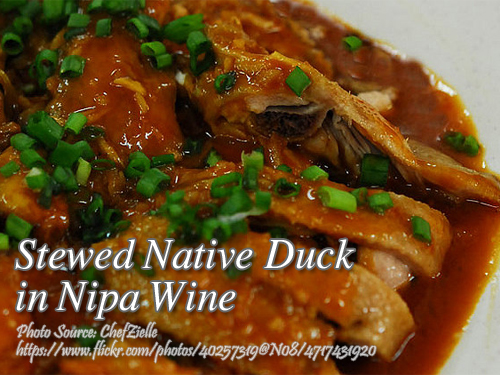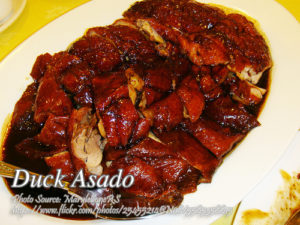Stewed native duck in nipa wine is a unique way of cooking duck stew using nipa wine or “tuba”. This native wine comes from coconut sap collected by snipping the stem called the florescence and attaching a bamboo pole. The product derived from the sap is either wine or vinegar. Cooking meat using coconut wine has a distinct flavor compared to using ordinary cooking wine.
Stewed Native Duck in Nipa Wine: A Family Dish with a Twist
I still remember the first time I tasted stewed native duck cooked in nipa wine. It was during a summer visit to my Uncle Boy in Quezon, where nipa palms grow along the rivers. He had this way of turning simple backyard ingredients into unforgettable meals. That afternoon, while my cousins and I were busy cracking open santol fruits, he was already simmering duck meat in a clay pot, filling the kitchen with the sweet-sour aroma of tuba.
“Duck is tougher than chicken,” Uncle Boy would say, “so you have to coax the flavor out gently.” He was right. By the time we gathered at the table, the duck had softened beautifully, the meat absorbing both the tang of nipa wine and the sweetness of pineapple juice. It was a dish that felt both rustic and festive, perfect with a steaming mound of rice.
Why Nipa Wine Makes a Difference
Nipa wine, or tuba, has long been part of Filipino kitchens, especially in the provinces. It’s made from the sap of the coconut or nipa palm, collected in bamboo tubes. Depending on how it’s aged, tuba can turn into a slightly sweet wine or a sharp vinegar. When used in cooking, the wine’s natural sugars balance the strong flavor of duck, while its acidity helps tenderize the meat.
That’s why stews like this work so well. The combination of simmering low and slow with nipa wine doesn’t just cook the duck—it transforms it. The technique allows tough meat fibers to break down while keeping the natural richness intact. Unlike ordinary cooking wine, nipa wine lends a taste that’s both earthy and faintly fruity, something truly Filipino.
Cooking the Stew at Home
When I tried making duck stew with nipa wine myself, I followed the same process my uncle taught me. The first step is to let the duck mingle with nipa wine and pineapple juice in the pot before the heat even starts. This early soaking stage is important—it allows the flavors to penetrate the meat right from the beginning.
As it simmers uncovered, the sharp bite of the alcohol cooks off, leaving behind only the flavor. Once the pot is covered and the heat lowered, the real magic begins. Slowly, the duck softens in its bath of wine and juice, turning tender without losing its structure.
Patience is key here. Rushing the stew will leave you with chewy meat and a watery sauce. But given time, the liquid thickens naturally into a glossy, sweet-savory glaze. Toward the end, adding pineapple tidbits, carrots, soy sauce, and pepper rounds out the dish. Each ingredient has its role: pineapple brightens the flavor, carrots add color and a touch of sweetness, soy sauce deepens the hue, and pepper provides warmth.
Memories in Every Bite
My sister Liza once cooked this dish when she moved to Leyte for work. She said it reminded her of home, especially during rainy nights when the sound of pouring rain echoed through the roof. “It’s the kind of food that makes you want to linger at the table,” she told me over the phone. And she was right—stewed native duck in nipa wine isn’t a hurried meal. It’s something to savor slowly, spoonful after spoonful, with plenty of rice and good conversation.
In our family, this dish always sparks stories. Someone recalls how Grandpa Pablo used to climb coconut trees to tap the sap. Another cousin remembers sneaking sips of fresh tuba straight from the bamboo pole, only to get scolded for being too curious. Food like this is more than just sustenance—it’s a living memory, a bridge to traditions that continue to thrive.
A Bit of Food History
Did you know that cooking with tuba is a tradition dating back centuries? Early Filipinos discovered that this palm wine wasn’t just for drinking but also for flavoring and preserving food. In coastal communities, it was common to use nipa wine for marinating meats and even fish. Its ability to break down fibers and add a layer of complexity made it indispensable in local kitchens. That heritage continues today every time a pot of duck or pork simmers with tuba.
Serving Suggestions of Stewed Native Duck
This Filipino duck stew pairs perfectly with hot white rice, but if you want to make it extra special, serve it with garlic fried rice on the side. The garlicky crunch balances the sweet-savory sauce of the duck. A small dipping sauce of fish sauce with calamansi also helps cut through the richness, giving each bite a refreshing lift.
Final Thoughts
Cooking stewed native duck with nipa wine is more than following a recipe—it’s about keeping alive a practice that connects us to family, land, and culture. Whether you learned it from an uncle in Quezon, a grandmother in Bicol, or a friend in Leyte, this dish carries with it the essence of Filipino kitchens: resourceful, flavorful, and always shared with love.
So the next time you come across fresh duck and a bottle of tuba, don’t hesitate. Bring out your pot, take your time, and let the aroma fill your home. Who knows—you might just start a new family tradition of your own.
How to Cook Stewed Native Duck in Nipa Wine
Ingredients
- 1 whole duck or itik about 2 kilos, dressed cleaned, cut in serving pieces
- 3 cups Fresh nipa wine or tuba about 2-3 cups
- 1 cup pineapple juice as desired, to sweeten
- 1 cup pineapple tidbits
- 1 pc carrot sliced
- 1/2 cup soy sauce
- Peppercorn and MSG
Instructions
How to cook stewed native duck in nipa wine:
- Put duck in a pot and add nipa wine and pineapple juice then bring to a boil uncovered.
- Then lower heat and boil, covered till duck meat is tender.
- Uncover and let the sauce simmer till thickened and sweet.
- In the last 5 minutes, add pineapple tidbits, carrots, soy sauce (for color), freshly ground black peppercorn and MSG. Serve hot with cooked rice.
Notes
Cooking Tips:
Marinate Early with Nipa Wine
Before cooking, let the duck sit in nipa wine and pineapple juice for at least 20 minutes. This early marination helps the flavors seep deep into the meat. It also begins the tenderizing process, making the duck less tough once it simmers.Simmer Low and Slow
Duck meat is naturally firmer than chicken, so rushing the process won’t work. Keep the heat low and allow the stew to cook gently until the meat becomes tender. This technique ensures the sauce thickens naturally and the flavors blend beautifully.Add Pineapple and Carrots at the End
Pineapple tidbits and carrots should be added only in the last few minutes of cooking. This way, the fruits and vegetables retain their color, texture, and natural sweetness. Overcooking them would make the dish mushy and overly sweet.






Leave a Reply